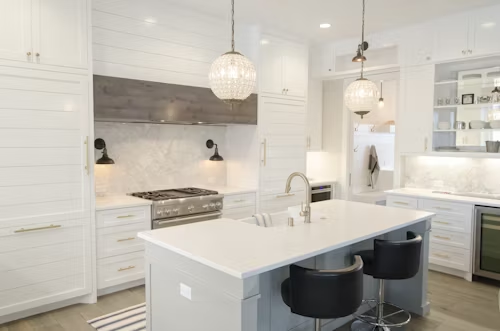
The kitchen is often called the heart of the home, and it’s easy to see why. It’s where meals are prepared, family gatherings happen, and daily routines unfold. One of the most important design elements of any kitchen is the cabinetry. The right kitchen cabinets not only provide essential storage but also enhance the overall aesthetic and functionality of the space. Whether you’re remodeling your kitchen or building a new home, choosing the perfect cabinets is a key step toward creating the kitchen of your dreams.
In this guide, we’ll walk you through the critical factors to consider when selecting kitchen cabinets, helping you make an informed decision that balances style, functionality, and budget.
1. Understanding Your Kitchen’s Style
The first step in selecting the right kitchen cabinets is to understand your kitchen’s overall style. Is it modern, traditional, rustic, or transitional? The style of your cabinets should align with the overall design aesthetic of your kitchen and home.
- Modern Kitchens: If your kitchen has a modern look, sleek cabinets with minimal detailing, flat surfaces, and hidden hardware are ideal. Choose finishes like matte or gloss in neutral colors like white, gray, or black.
- Traditional Kitchens: For a more classic feel, go with cabinets that have raised panels, decorative moldings, and ornate hardware. Wood tones or soft, muted colors like cream and beige can enhance the warmth of a traditional kitchen.
- Rustic Kitchens: If you’re leaning toward a rustic or farmhouse vibe, opt for natural wood finishes, shaker-style doors, and open shelving to showcase your kitchen’s cozy charm.
- Transitional Kitchens: For those who love a mix of traditional and contemporary elements, transitional kitchens strike a balance. These kitchens feature simple cabinetry with clean lines but often incorporate warm wood finishes or muted colors to soften the modern feel.
2. Materials Matter
The material you choose for your kitchen cabinets will affect their durability, appearance, and maintenance. Here are some common options:
- Solid Wood: Known for its durability and timeless appeal, solid wood is a popular choice for cabinets. Different types of wood, like oak, maple, and cherry, each have unique grain patterns and color tones that can give your kitchen a distinctive look. Solid wood cabinets may be more expensive but are known for their longevity.
- Plywood: A strong and cost-effective alternative to solid wood, plywood is composed of layered wood veneer sheets. It’s highly durable and resistant to warping, making it a great choice for humid kitchen environments.
- Medium-Density Fiberboard (MDF): MDF is a cheaper alternative to solid wood and plywood. It has a smooth surface that can be easily painted, making it a versatile choice for homeowners looking to achieve a specific color or finish. However, MDF may not be as durable as wood or plywood.
- Laminate: If you’re looking for a low-maintenance option, laminate cabinets are easy to clean and come in a wide range of colors and textures. However, they may not offer the same high-end appeal as wood or plywood.
3. Storage Needs and Layout
While the look of your cabinets is essential, their functionality is equally important. Consider how you use your kitchen and what your storage needs are. This will help determine the cabinet layout and design that will work best for you.
- Maximizing Vertical Space: Tall cabinets that extend to the ceiling can make the most of vertical space, offering additional storage for items that aren’t frequently used. This is especially useful in smaller kitchens where floor space is limited.
- Drawers vs. Shelves: While traditional cabinets with shelves are still popular, more homeowners are opting for deep drawers. Drawers allow for easy access to pots, pans, and smaller kitchen items, reducing the need to bend over or rummage through cluttered shelves.
- Custom Storage Solutions: Today’s cabinets come with an array of built-in storage options, from pull-out spice racks and lazy Susans to built-in trash bins and tray dividers. Tailor your storage to fit your cooking habits and the items you use most frequently.
4. Cabinet Finishes and Colors
The finish of your kitchen cabinets plays a significant role in defining the kitchen’s ambiance. From natural wood tones to painted surfaces, the right finish can transform the look of your space.
- Natural Wood Finishes: If you want a warm, traditional feel, natural wood cabinets with a clear or tinted stain bring out the grain of the wood and add character to your kitchen.
- Painted Finishes: For a more modern or clean look, painted cabinets are a popular option. White remains a timeless choice, but shades of gray, navy, and even black are gaining popularity for a more dramatic look.
- Glazed Finishes: A glazed finish can give cabinets an antique or distressed appearance, adding depth and texture to a rustic or traditional kitchen.
- High Gloss or Matte: For modern kitchens, high-gloss cabinets add a sleek, reflective finish that can make the space feel larger. Matte finishes, on the other hand, offer a more understated and contemporary look.
5. Budgeting for Your Cabinets
When planning your kitchen renovation, it’s essential to establish a budget for your cabinets, as they typically account for a significant portion of the kitchen’s overall cost. Custom cabinets offer the most flexibility in terms of style and size but are often the most expensive. Semi-custom and stock cabinets are more affordable and come in a range of styles and finishes.
Final Thoughts
Choosing the right kitchen cabinets can make or break the functionality and aesthetic of your kitchen. Whether you prioritize style, storage, or budget, there’s a wide variety of options to suit your needs. Take the time to explore different styles, materials, and finishes to find the perfect fit for your home. By selecting high-quality cabinets that align with your lifestyle and design preferences, you’ll create a kitchen that is both beautiful and practical for everyday living.







